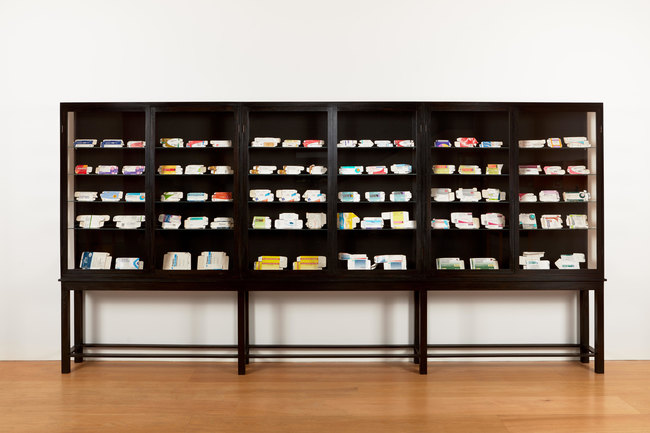Exhibitions2021BIG MEDICINE


BIG MEDICINE
7 Aug - 31 Oct 21
‘Big Medicine,’ is a bold, celebratory show across all three major galleries within GIANT. Featuring works by major international artists such as Jake and Dinos Chapman, Jim Lambie and Gavin Turk, it takes an optimistic, humorous and entertaining approach in demonstrating the utility art has to re-unite societal ties in public space. Also exhibited are Gary Card, Nicky Carvell, Paola Ciarska, Eva Cremers, Chad Person, Anthony Rodinone, Paul Fryer and Paul Trefry.
‘Big Medicine’ sets the agenda for the gallery in future years. Taking its position in a small and largely culturally underserved seaside town of Bournemouth, here GIANT knowingly pokes fun at its high street location, issuing a rally cry for the importance of the arts to heal cultural wounds through shared experience. It has a subtle yet potent backdrop of counter cultural moments of connection – times in which the arts have moved us forward societally, from the 1967 summer of love, through to the 90s illegal rave scene, overlaid with the trials and tribulations of technology and science.
‘Big Medicine’ is an exhibition on both a grand and microscopic scale. From giant inflatables and immersive rooms to miniature paintings, by both internationally renowned artists and new emerging voices, this vast exhibition serves to celebrate and re-ignite our connection with one another in public space. With our lives increasingly dominated by the digital, the show is an invitation to get physical, to play and to interact, allowing art and the space it inhabits to act as a mediator in us reuniting and seeing one another again in a new light.
Technology and the pandemic have created the perfect storm for fear and atomization, and the exhibition is a timely and poignant reminder that the world we have returned to has changed drastically from the one we left behind pre-pandemic. In ‘Big Medicine’, curator Stuart Semple attempts to test the radical assumption that the experience of art could have a positive sociological effect on cultural wounding. Art itself could be the biggest cultural medicine we have.
Visitors are greeted by Chad Person’s gigantic inflatable sculpture Underdog, a cartoon canine in a superhero costume, staring down at his mobile phone, and Jake and Dinos Chapman present a series of bronze-cast suicide vests, the form of which is inspired by youtube clips of suicide bombers. The works, whilst reminiscent of Jeff Koons ‘Aqualung’ (1985), are hand painted in bright colours, featuring art materials where one would expect explosives. As one would expect from the brothers, a dialogue with death ensues, in which the risk and danger of being an artist is pitched against the power of the artist's conviction to fight for belief.
Bournemouth-born Gary Card returns to his hometown to create a fully immersive installation based on the ‘Hysterical’ world he built at Phillips auction house in London in 2019. Paul Trefry, well-known for photo realistic sculptures that question societal issues such as loneliness or homelessness, exhibits two works previously unseen in the UK – one a double life-sized sculpture of homeless man, the other a tiny old lady, waiting indefinitely on a park bench for a husband who never arrives.
The perfectionist pop aesthetic of Damien Hirst’s medicine cabinets is challenged by Gavin Turk in his own cabinet, in which he replaces Hirst’s meticulous pills with the detritus of pharmaceutical packaging, making us redress utopian images of the perfect society and challenging notions of birth, death and decay.
Paul Fryer’s Telstar (Understanding), is constructed from mixed exotic woods, and references Telstar 1, which launched on top of a Thor-Delta rocket on July 10, 1962 – it successfully relayed through space the first telephone calls, telegraph images, and transmitted the first live transatlantic television images: an American flag waving in the wind; a still image of Mount Rushmore; French singer Yves Montand, looking suave. And on July 23, 1962, President John F. Kennedy. At just under 3ft in diameter and powered by solar power, this object has had a potent and profound effect on mass communication, sowing the seeds for the connected world we inhabit today. Using this as a touchstone for the sculpture, Fryer explores notions of temporality, physics and the universe.
The back of the gallery houses a site-specific piece by Jim Lambie. This intervention recreates his iconic ZoBop vinyl floor, originally installed in the Scottish National Gallery. The work defines the space as a site of art and co-opts the architecture, once made for the pure aesthetic experience of shopping. It stands as a strong testament to purpose and reclamation of the high street as a site of artistic endeavour, a theme that continues in Nicky Carvell’s work, who presents the decay of the traditional town centre in a new stained-glass window installation created specifically for the show.
